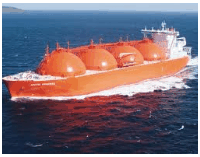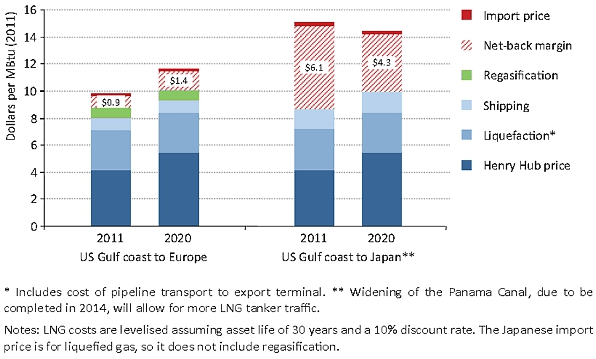
In September last year, The Australian newspaper revealed that Japan was attempting to sever oil-linked pricing for Japanese liquefied natural gas (LNG) imports.
Oil-linked pricing for Japanese LNG imports began in the 1960s. The gas price was linked to the price of oil because it was the substitute for Japanese power generation at that time. At an oil price of $US100 a barrel, LNG landed in Japan from Australia reportedly costs around $US14 per gigajoule. The price currently slightly higer still:

However, with the LNG price in the US having fallen amid the shale gas revolution, and the associated talk of large-scale exports from the US and Africa, the Japanese appear to be seeking to end the oil-linked pricing system in order to ease Japan’s soaring energy costs.
The Japanese have a history of making sensible decisions with energy supply, acceding enough pricing power to suppliers to cover the high capital costs of supply development, usually via long-term contracts. The move by the Japanese to break the oil benchmark should be seen, therefore, as an acknowledgement of a developing and long-term gas glut.
There are reportedly 15 large LNG projects seeking approval to export from the US to non-FTA nations (i.e. Asia and Europe). And according to the recently published International Energy Agency (IEA) annual report, the profit margin available from exporting gas to Asia is expected to remain far more attractive than prices available within the US (see below chart), suggesting that the desire to export LNG from the US will only grow.

Late last week, it was revealed that Japan’s Tokyo Electric Power Company (TEPCO) have announced a deal to purchase US LNG linked to the Henry Hub natural gas benchmark for a period of 20 years, commencing in 2017 (h/t 3d1k):
As a result of discussing the purchase of LNG from the U.S. Cameron Project with the seller, Mitsui & Co., Ltd., we have agreed on the initial terms and conditions of the transaction. We are also in the final discussion with Mitsubishi Corporation to reach a basic agreement on the purchase of LNG from the project. We will continue discussions with Mitsui & Co., Ltd. and Mitsubishi Corporation towards the conclusion of the final sales and purchase contract.
In accordance with the contracts, we will be purchasing an annual amount of approx. 800,000 tons and an optional amount (under discussion) of LNG starting from 2017 for the period of about 20 years. The natural gas linked price (Henry Hub linked price*1) is planned to be applied to the price index for the first time in a TEPCO long-term LNG contract.
The U.S. Cameron Project is an LNG project being planned in the State of Louisiana by Cameron LNG, a subsidiary of Sempra Energy. Mitsui & Co., Ltd. and Mitsubishi Corporation are currently in discussion with Cameron LNG regarding a tolling agreement of processing natural gas including shale gas produced in the U.S. . Once the final sales contract is concluded between TEPCO, Mitsui & Co., Ltd. and Mitsubishi Corporation, it will significantly contribute to our stable procurement of LNG…
We consider this as the first step towards achieving the target of 10 million tons (annual) of lean LNG…
We will continue our efforts towards stable and reasonable power supply and stable procurement of economical fuels including lean LNG.
As noted by 3d1k, the proposal to produce and export LNG from the US Cameron Project faces some hurdles, including challenges from environmental groups as well as requiring enabling legislation allowing sales of LNG to non-FTA countries. Nevertheless, it appears that the LNG shift is on, which is bad news for Australia’s LNG exporters.

